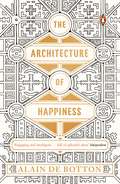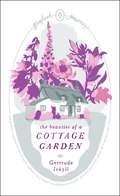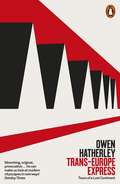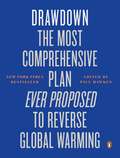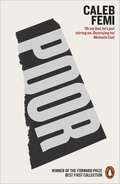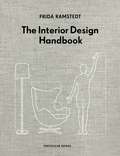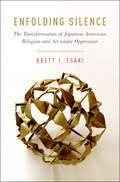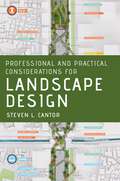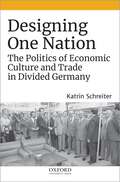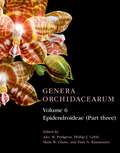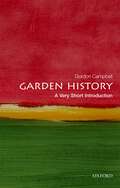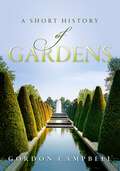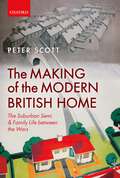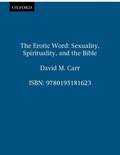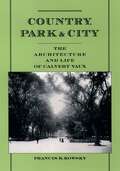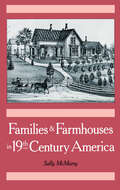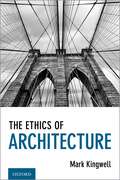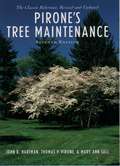- Table View
- List View
The Architecture of Happiness: The Architecture Of Happiness (Vintage International Series)
by Alain De BottonThe Architecture of Happiness is Alain de Botton's exploration of the hidden links between buildings and our well beingBestselling author Alain de Botton has written about love, travel, status and how philosophy can console us. Now he turns his attention to one of our most intense but often hidden love affairs: with our houses and their furnishings. He asks: What makes a house truly beautiful?Why are many new houses so ugly?Why do we argue so bitterly about sofas and pictures - and can differences of taste ever be satisfactorily resolved?Will minimalism make us happier than ornaments? To answer these questions and many more, de Botton looks at buildings across the world, from medieval wooden huts to modern skyscrapers; he examines sofas and cathedrals, tea sets and office complexes, and teases out a host of often surprising philosophical insights. The Architecture of Happiness will take you on a beguiling tour through the history and psychology of architecture and interior design, and will forever alter your relationship with buildings. It will change the way you look at your current home - and help you make the right decisions about your next one.'Engaging and intelligent . . . full of splendid ideas, happily and beautifully expressed'IndependentAlain de Botton was born in 1969 and is the author of non-fiction essays on themes ranging from love and travel to architecture and philosophy. His bestselling books include Essays in Love; The Romantic Movement; Kiss and Tell; Status Anxiety; How Proust Can Change Your Life; The Pleasures and Sorrows of Work; The Art of Travel; The Architecture of Happiness and Religion for Atheists. He lives in London and founded The School of Life (www.theschooloflife.com) and Living Architecture (www.living-architecture.co.uk). For more information, consult www.alaindebotton.com.
The Beauties of a Cottage Garden
by Gertrude JekyllThis is a celebration of the beauties and possibilities of Heliotrope and Honeysuckle, Auricula, Snapdragon, Spanish Iris and Corydalis, and all the other plants that enliven and exalt the gardens of England. Gertrude Jekyll gives good advice on how to make a garden a place of repose and pleasure. Writing with enthusiasm on the colours and scents of flowers, on the frustrations (and delights) of weeding and on the debasing influence of flower shows, she is practical, wise and entertaining in equal measure.Generations of inhabitants have helped shape the English countryside - but it has profoundly shaped us too.It has provoked a huge variety of responses from artists, writers, musicians and people who live and work on the land - as well as those who are travelling through it.English Journeys celebrates this long tradition with a series of twenty books on all aspects of the countryside, from stargazey pie and country churches, to man's relationship with nature and songs celebrating the patterns of the countryside (as well as ghosts and love-struck soldiers).
Trans-Europe Express: Tours of a Lost Continent
by Owen Hatherley'A scathing, lively and timely look at the "European city", from one of our most provocative voices on culture and architecture today' Owen JonesA searching, timely account of the condition of contemporary Europe, told through the landscapes of its citiesOver the past twenty years European cities have become the envy of the world: a Kraftwerk Utopia of historic centres, supermodernist concert halls, imaginative public spaces and futuristic egalitarian housing estates which, interconnected by high-speed trains traversing open borders, have a combination of order and pleasure which is exceptionally unusual elsewhere.In Trans-Europe Express, Owen Hatherley sets out to explore the European city across the entire continent, to see what exactly makes it so different to the Anglo-Saxon norm - the unplanned, car-centred, developer-oriented spaces common to the US, Ireland, UK and Australia. Attempting to define the European city, Hatherley finds a continent divided both within the EU and outside it. 'The latest heir to Ruskin.' - Boyd Tonkin, Independent 'Hatherley is the most informed, opinionated and acerbic guide you could wish for.' - Hugh Pearman, Sunday Times 'Can one talk yet of vintage Hatherley? Yes, one can. Here are all the properties that have made him one of the most distinctive writers in England - not just 'architectural writers', but writers full stop: acuity, contrariness, observational rigour, frankness and beautifully wrought prose.' - Jonathan Meades
Goodbye, Things: On Minimalist Living
by Fumio Sasaki'Meet the new king of decluttering' - The Times'Take your spring cleaning to the next level with Goodbye, Things by Fumio Sasaki' - Parade'There's happiness in having less. If you are anything like how I used to be - miserable, constantly comparing yourself with others, or just believing your life sucks - I think you should try saying goodbye to some of your things'Fumio Sasaki is a writer in his thirties who lives in a tiny studio in Tokyo with three shirts, four pairs of trousers, four pairs of socks and not much else. A few years ago, he realised that owning so much stuff was weighing him down - so he started to get rid of it.In this hit Japanese bestseller, Sasaki explores the philosophy behind minimalism and offers a set of straightforward rules - discard it if you haven't used it in a year; be a borrower; find your uniform; keep photos of the things you love - that can help all of us lead simpler, happier, more fulfilled lives.
Drawdown: The Most Comprehensive Plan Ever Proposed to Reverse Global Warming
by Paul HawkenNEW YORK TIMES BESTSELLERFor the first time ever, an international coalition of leading researchers, scientists and policymakers has come together to offer a set of realistic and bold solutions to climate change. All of the techniques described here - some well-known, some you may have never heard of - are economically viable, and communities throughout the world are already enacting them. From revolutionizing how we produce and consume food to educating girls in lower-income countries, these are all solutions which, if deployed collectively on a global scale over the next thirty years, could not just slow the earth's warming, but reach drawdown: the point when greenhouse gasses in the atmosphere peak and begin todecline. So what are we waiting for?
Poor
by Caleb Femi'An urban romantic ... powerful' Dazed & Confused 'A poet of truth and rage, heartbreak and joy' Max PorterWhat is it like to grow up in a place where the same police officer who told your primary school class they were special stops and searches you at 13 because 'you fit the description of a man' - and where it is possible to walk two and a half miles through an estate of 1,444 homes without ever touching the ground?In Poor, Caleb Femi combines poetry and original photography to explore the trials, tribulations, dreams and joys of young Black boys in twenty-first century Peckham. He contemplates the ways in which they are informed by the built environment of concrete walls and gentrifying neighbourhoods that form their stage, writes a coded, near-mythical history of the personalities and sagas of his South London youth, and pays tribute to the rappers and artists who spoke to their lives.Above all, this is a tribute to the world that shaped a poet, and to the people forging difficult lives and finding magic within it. As Femi writes in one of the final poems of this book: 'I have never loved anything the way I love the endz.'
The Interior Design Handbook: Furnish, Decorate, And Style Your Space
by Frida RamstedtTHE BESTSELLING SWEDISH PHENOMENONWhat looks good and why?Design consultant Frida Ramstedt runs Scandinavia's leading interior design blog. In this book she distils the secrets of successful interior design and styling to help you create a home that works best for your space, taste and lifestyle. Filled with practical tips, rules-of-thumb and tricks of the trade, The Interior Design Handbook will help you to think like a professional designer.
Enfolding Silence: The Transformation of Japanese American Religion and Art under Oppression (AAR Academy Series)
by Brett J. EsakiThis book demonstrates how Japanese Americans have developed traditions of complex silences to survive historic moments of racial and religious oppression and how they continue to adapt these traditions today. Brett Esaki offers four case studies of Japanese American art-gardening, origami, jazz, and monuments-and examines how each artistic practice has responded to a historic moment of oppression. He finds that these artistic silences incorporate and convey obfuscated and hybridized religious ideas from Buddhism, Christianity, Confucianism, Shinto, indigenous religions, and contemporary spirituality. While silence is often thought of as the binary opposite and absence of sound, Esaki offers a theory of non-binary silence that articulates how multidimensional silences are formed and how they function. He argues that non-binary silences have allowed Japanese Americans to disguise, adapt, and innovate religious resources in order to negotiate racism and oppressive ideologies from both the United States and Japan. Drawing from the fields of religious studies, ethnic studies, theology, anthropology, art, music, history, and psychoanalysis, this book highlights the ways in which silence has been used to communicate the complex emotions of historical survival, religious experience, and artistic inspiration.
Enfolding Silence: The Transformation of Japanese American Religion and Art under Oppression (AAR Academy Series)
by Brett J. EsakiThis book demonstrates how Japanese Americans have developed traditions of complex silences to survive historic moments of racial and religious oppression and how they continue to adapt these traditions today. Brett Esaki offers four case studies of Japanese American art-gardening, origami, jazz, and monuments-and examines how each artistic practice has responded to a historic moment of oppression. He finds that these artistic silences incorporate and convey obfuscated and hybridized religious ideas from Buddhism, Christianity, Confucianism, Shinto, indigenous religions, and contemporary spirituality. While silence is often thought of as the binary opposite and absence of sound, Esaki offers a theory of non-binary silence that articulates how multidimensional silences are formed and how they function. He argues that non-binary silences have allowed Japanese Americans to disguise, adapt, and innovate religious resources in order to negotiate racism and oppressive ideologies from both the United States and Japan. Drawing from the fields of religious studies, ethnic studies, theology, anthropology, art, music, history, and psychoanalysis, this book highlights the ways in which silence has been used to communicate the complex emotions of historical survival, religious experience, and artistic inspiration.
Professional and Practical Considerations for Landscape Design
by Steven L. CantorDrawing on decades of professional practice and teaching experience, Steven L. Cantor's Professional and Practical Considerations for Landscape Design explains the field of landscape architecture, outlining with authority how to turn drawings of designs into creative, purposeful, and striking landscapes and landforms in today's world. This comprehensive guide consists of everything a young professional might encounter from conception through final project archiving, ensuring readers have both the tools necessary to keep up with advancements in the field and the practical business knowledge to build life-long partnerships. Each of the book's concise chapters emphasize a specific aspect of landscape architecture practice, from the administration of designs for contracts, areas of practice, human resources, marketing, construction materials, sustainability and ethics. Each chapter is written in a style that best suits the material. Alongside detailed definitions and practical "do's and don'ts" are 30 complex sample problems ranging in difficulty for both individuals and groups. An array of original photographs and clear examples in both black and white and color articulate standards and inspire future possibilities, featuring the work of Vicky Chan, founder of Avoid Obvious Architects, and Richard Alomar, Associate Professor of Landscape Architecture at Rutgers and co-founder of New York Urban Sketchers. By combining the author's unique depth of knowledge with real-world case studies from America, Asia, and Europe, Professional and Practical Considerations for Landscape Design is an up-to-date resource for every level of reader, from students in landscape architecture programs to professionals working in public or private practice, engineering, consulting, or contracting.
Designing One Nation: The Politics of Economic Culture and Trade in Divided Germany
by Katrin SchreiterThis is an open access title available under the terms of a CC BY-NC-ND 4.0 International License. It is free to read at Oxford Scholarship Online and offered as a free PDF download from OUP and selected open access locations, thanks to a generous grant from the Andrew W. Mellon Foundation. The histories of East and West Germany traditionally emphasize the Cold War rivalries between the communist and capitalist nations. Yet, even as the countries diverged in their political directions, they had to create new ways of working together economically. In Designing One Nation, Katrin Schreiter examines the material culture of increasing economic contacts in divided Germany from the 1940s until the 1990s. Trade events, such as fairs and product shows, became one of the few venues for sustained links and knowledge between the two countries after the building of the Berlin Wall. Schreiter uses industrial design, epitomized by the furniture industry, to show how a network of politicians, entrepreneurs, and cultural brokers attempted to nationally re-inscribe their production cultures, define a postwar German identity, and regain economic stability and political influence in postwar Europe. What started as a competition for ideological superiority between East and West Germany quickly turned into a shared, politically legitimizing quest for an untainted post-fascist modernity. This work follows products from the drawing board into the homes of ordinary Germans to offer insights into how converging visions of German industrial modernity created shared expectations about economic progress and living standards. Schreiter reveals how intra-German and European trade policies drove the creation of products and generated a certain convergence of East and West German taste by the 1980s. Drawing on a wide range of sources from governments, furniture firms, industrial design councils, home lifestyle magazines, and design exhibitions, Designing One Nation argues that an economic culture linked the two Germanies even before reunification in 1990.
Designing One Nation: The Politics of Economic Culture and Trade in Divided Germany
by Katrin SchreiterThis is an open access title available under the terms of a CC BY-NC-ND 4.0 International License. It is free to read at Oxford Scholarship Online and offered as a free PDF download from OUP and selected open access locations, thanks to a generous grant from the Andrew W. Mellon Foundation. The histories of East and West Germany traditionally emphasize the Cold War rivalries between the communist and capitalist nations. Yet, even as the countries diverged in their political directions, they had to create new ways of working together economically. In Designing One Nation, Katrin Schreiter examines the material culture of increasing economic contacts in divided Germany from the 1940s until the 1990s. Trade events, such as fairs and product shows, became one of the few venues for sustained links and knowledge between the two countries after the building of the Berlin Wall. Schreiter uses industrial design, epitomized by the furniture industry, to show how a network of politicians, entrepreneurs, and cultural brokers attempted to nationally re-inscribe their production cultures, define a postwar German identity, and regain economic stability and political influence in postwar Europe. What started as a competition for ideological superiority between East and West Germany quickly turned into a shared, politically legitimizing quest for an untainted post-fascist modernity. This work follows products from the drawing board into the homes of ordinary Germans to offer insights into how converging visions of German industrial modernity created shared expectations about economic progress and living standards. Schreiter reveals how intra-German and European trade policies drove the creation of products and generated a certain convergence of East and West German taste by the 1980s. Drawing on a wide range of sources from governments, furniture firms, industrial design councils, home lifestyle magazines, and design exhibitions, Designing One Nation argues that an economic culture linked the two Germanies even before reunification in 1990.
Professional and Practical Considerations for Landscape Design
by Steven L. CantorDrawing on decades of professional practice and teaching experience, Steven L. Cantor's Professional and Practical Considerations for Landscape Design explains the field of landscape architecture, outlining with authority how to turn drawings of designs into creative, purposeful, and striking landscapes and landforms in today's world. This comprehensive guide consists of everything a young professional might encounter from conception through final project archiving, ensuring readers have both the tools necessary to keep up with advancements in the field and the practical business knowledge to build life-long partnerships. Each of the book's concise chapters emphasize a specific aspect of landscape architecture practice, from the administration of designs for contracts, areas of practice, human resources, marketing, construction materials, sustainability and ethics. Each chapter is written in a style that best suits the material. Alongside detailed definitions and practical "do's and don'ts" are 30 complex sample problems ranging in difficulty for both individuals and groups. An array of original photographs and clear examples in both black and white and color articulate standards and inspire future possibilities, featuring the work of Vicky Chan, founder of Avoid Obvious Architects, and Richard Alomar, Associate Professor of Landscape Architecture at Rutgers and co-founder of New York Urban Sketchers. By combining the author's unique depth of knowledge with real-world case studies from America, Asia, and Europe, Professional and Practical Considerations for Landscape Design is an up-to-date resource for every level of reader, from students in landscape architecture programs to professionals working in public or private practice, engineering, consulting, or contracting.
Genera Orchidacearum Volume 6: Epidendroideae (part 3) (Genera Orchidacearum)
by Alec M. Pridgeon Phillip J. Cribb Mark W. Chase Finn N. RasmussenFor centuries orchids have been among the most popular of plant families, with thousands of species and hybrids cultivated worldwide for the diversity, beauty, and intricacy of their flowers. The Genera Orchidacearum series represents a robust and natural classification of the orchids, something that has eluded plant scientists and orchid enthusiasts for years. The editors, who are all distinguished orchid specialists, incorporate a wealth of new DNA data into a truly phylogenetic classification, identifying the areas and taxa that merit additional work. To this end, they have invited several international specialists to contribute in their particular areas of expertise. Each volume provides comprehensive coverage of one or two orchid subfamilies, and the series as a whole will be an indispensable reference tool for scientists, orchid breeders, and growers. Orchidaceae is the largest monocotyledon family and perhaps the largest plant family in terms of number of species, approximately 25,000. Although the fossil record is limited, active molecular research in recent years has unravelled many of the complexities and phylogenetics of this cosmopolitan plant family. This sixth and final volume treats 140 genera in tribes Dendrobieae and Vandeae of the largest subfamily, Epidendroideae, including some of the showiest orchids often used in hybridizing. Comprehensive treatments are provided for each genus, which include complete nomenclature, description, distribution (with map), anatomy, palynology, cytogenetics, phytochemistry, phylogenetics, pollination, ecology, and economic uses. Cultivation notes are included for those genera known to be in hobbyist collections. Genera are beautifully illustrated with line drawings and colour photographs. An Addendum updates a few generic accounts published in past volumes. A cumulative glossary, list of generic synonyms with their equivalents, and list of all series contributors round out this final volume in the series.
Garden History: A Very Short Introduction (Very Short Introductions)
by Gordon CampbellGardens take many forms, and have a variety of functions. They can serve as spaces of peace and tranquilty, a way to cultivate wildlife, or as places to develop agricultural resources. Globally, gardens have inspired, comforted, and sustained people from all walks of life, and since the Garden of Eden many iconic gardens have inspired great artists, poets, musicians, and writers. In this Very Short Introduction, Gordon Campbell embraces gardens in all their splendour, from parks, and fruit and vegetable gardens to ornamental gardens, and takes the reader on a globe-trotting historical journey through iconic and cultural signposts of gardens from different regions and traditions. Ranging from the gardens of ancient Persia to modern day allotments, he concludes by looking to the future of the garden in the age of global warming, and the adaptive spirit of human innovation. ABOUT THE SERIES: The Very Short Introductions series from Oxford University Press contains hundreds of titles in almost every subject area. These pocket-sized books are the perfect way to get ahead in a new subject quickly. Our expert authors combine facts, analysis, perspective, new ideas, and enthusiasm to make interesting and challenging topics highly readable.
Garden History: A Very Short Introduction (Very Short Introductions)
by Gordon CampbellGardens take many forms, and have a variety of functions. They can serve as spaces of peace and tranquilty, a way to cultivate wildlife, or as places to develop agricultural resources. Globally, gardens have inspired, comforted, and sustained people from all walks of life, and since the Garden of Eden many iconic gardens have inspired great artists, poets, musicians, and writers. In this Very Short Introduction, Gordon Campbell embraces gardens in all their splendour, from parks, and fruit and vegetable gardens to ornamental gardens, and takes the reader on a globe-trotting historical journey through iconic and cultural signposts of gardens from different regions and traditions. Ranging from the gardens of ancient Persia to modern day allotments, he concludes by looking to the future of the garden in the age of global warming, and the adaptive spirit of human innovation. ABOUT THE SERIES: The Very Short Introductions series from Oxford University Press contains hundreds of titles in almost every subject area. These pocket-sized books are the perfect way to get ahead in a new subject quickly. Our expert authors combine facts, analysis, perspective, new ideas, and enthusiasm to make interesting and challenging topics highly readable.
Gardens: A Short History
by Gordon CampbellGardens take many forms, and have a variety of functions. They can serve as spaces of peace and tranquilty, a way to cultivate wildlife, or as places to develop agricultural resources. Globally, gardens have inspired, comforted, and sustained people from all walks of life, and since the Garden of Eden many iconic gardens have inspired great artists, poets, musicians, and writers. In this short history, Gordon Campbell embraces gardens in all their splendour, from parks, and fruit and vegetable gardens to ornamental gardens, and takes the reader on a globe-trotting historical journey through iconic and cultural signposts of gardens from different regions and traditions. Ranging from the gardens of ancient Persia to modern day allotments, he concludes by looking to the future of the garden in the age of global warming, and the adaptive spirit of human innovation.
Gardens: A Short History
by Gordon CampbellGardens take many forms, and have a variety of functions. They can serve as spaces of peace and tranquilty, a way to cultivate wildlife, or as places to develop agricultural resources. Globally, gardens have inspired, comforted, and sustained people from all walks of life, and since the Garden of Eden many iconic gardens have inspired great artists, poets, musicians, and writers. In this short history, Gordon Campbell embraces gardens in all their splendour, from parks, and fruit and vegetable gardens to ornamental gardens, and takes the reader on a globe-trotting historical journey through iconic and cultural signposts of gardens from different regions and traditions. Ranging from the gardens of ancient Persia to modern day allotments, he concludes by looking to the future of the garden in the age of global warming, and the adaptive spirit of human innovation.
The Making Of The Modern British Home: The Suburban Semi And Family Life Between The Wars
by Peter ScottThe Making of the Modern British Home explores the impact of the modern suburban semi-detached house on British family life during the 1920s and 1930s - focusing primarily on working-class households who moved from cramped inner-urban accommodation to new suburban council or owner-occupied housing estates. Migration to suburbia is shown to have initiated a dramatic transformation in lifestyles - from a `traditional' working-class mode of living, based around long-established tightly-knit urban communities, to a recognisably `modern' mode, centred around the home, the nuclear family, and building a better future for the next generation. This process had far-reaching impacts on family life, entailing a change in household priorities to meet the higher costs of suburban living, which in turn impacted on many aspects of household behaviour, including family size. This volume also constitutes a general history of the development of both owner-occupied and municipal suburban housing estates in interwar Britain, including the evolution of housing policy; the housing development process; housing and estate design, lay-outs, and architectural features; marketing owner-occupation and consumer durables to a mass market; furnishing the new suburban home; making ends meet; suburban gardens; social filtering and conflict on the new estates; and problems of 'mis-selling' and 'Jerry building'. Peter Scott integrates the social history of the interwar suburbs with their economic, business, marketing, and architectural/planning histories, demonstrating how these elements interacted to produce a new model of working-class lifestyles and 'respectability' which marked a fundamental break with pre-1914 working-class urban communities.
The Erotic Word: Sexuality, Spirituality, And The Bible
by David M. CarrHistorically, the Bible has been used to drive a wedge between the spirit and the body. In this provocative book, David Carr argues that it can--and should--do just the opposite. Sexuality and spirituality, Carr contends, are intricately interwoven: when one is improverished, the other is warped. As a result, the journey toward God and the life-long engagement with our own sexual embodiment are inseparable. Humans, the Bible tells us, both male and female, were created in God's image, and eros--a fundamental longing for connection that finds abstract good in the pleasure we derive from the stimulation of the senses--is a central component of that image. The Bible, particularly the Hebrew Bible, affirms erotic passion, both eros between humans and eros between God and humans. In a sweeping examination of the sexual rules of the Bible, Carr asserts that Biblical "family values" are a far cry from anything promoted as such in contemporary politics. He concludes that passionate love--our preoccupaton therewith and pursuit thereof--is the primary human vocation, that eros is in fact the flavoring of life.
Country, Park & City: The Architecture and Life of Calvert Vaux
by Francis R. KowskyAfter beginning his career as an architect in London, Calvert Vaux (1824-1895) came to the Hudson River valley in 1850 at the invitation of Andrew Jackson Downing, the reform-minded writer on houses and gardens. As Downing's partner, and after Downing's death in 1852, Vaux designed country and suburban dwellings that were remarkable for their well-conceived plans and their sensitive rapport with nature. By 1857, the year he published his book Villas and Cottages, Vaux had moved to New York City. There he asked Frederick Law Olmsted to join him in preparing a design for Central Park. He spent the next 38 years defending and refining their vision of Central Park as a work of art. After the Civil War, he and Olmsted led the nascent American park movement with their designs for parks and parkways in Brooklyn, Buffalo, and many other American cities. Apart from undertakings with Olmsted, Vaux cultivated a distinguished architectural practice. Among his clients were the artist Frederic Church, whose dream house, Olana, he helped create; and the reform politician Samuel Tilden, whose residence on New York's Gramercy Park remains one of the country's outstanding Victorian buildings. A pioneering advocate for apartment houses in American cities, Vaux designed buildings that mirrored the advance of urbanization in America, including early model housing for the poor. He planned the original portions of the Metropolitan Museum of Art and the American Museum of Natural History and conceived a stunning proposal for a vast iron and glass building to house the Centennial Exhibition in Philadelphia. Especially notable are the many bridges and other charming structures that he designed for Central Park. Vaux considered the Park's Terrace, decorated by J. W. Mould, as his greatest achievement. An active participant in the cultural and intellectual life of New York, Vaux was an idealist who regarded himself as an artist and a professional. And while much has been written on Olmsted, comparatively little has been published about Vaux. The first in-depth account of Vaux's career, Country, Park, and City should be of great interest to historians of art, architecture, and urbanism, as well as preservationists and other readers interested in New York City's past and America's first parks.
Families and Farmhouses in Nineteenth-Century America: Vernacular Design and Social Change
by Sally McMurryThe antebellum era and the close of the 19th century frame a period of great agricultural expansion. During this time, farmhouse plans designed by rural men and women regularly appeared in the flourishing Northern farm journals. This book analyzes these vital indicators of the work patterns, social interactions, and cultural values of the farm families of the time. Examining several hundred owner-designed plans, McMurry shows the ingenious ways in which "progressive" rural Americans designed farmhouses in keeping with their visions of a dynamic, reformed rural culture. From designs for efficient work spaces to a concern for self-contained rooms for adolescent children, this fascinating story of the evolution of progressive farmers' homes sheds new light on rural America's efforts to adapt to major changes brought by industrialization, urbanization, the consolidation of capitalist agriculture, and the rise of the consumer society.
The Ethics of Architecture
by Mark KingwellA lively and accessible discussion of how architecture functions in a complex world of obligation and responsibility, with a preface offering specific discussion of architecture during and after the COVID-19 pandemic. What are the special ethical obligations assumed by architects? Because their work creates the basic material conditions that make all other human activity possible, architects and their associates in building enjoy vast influence on how we all live, work, play, worship, and think. With this influence comes tremendous, and not always examined, responsibility. This book addresses the range of ethical issues that architects face, with a broad understanding of ethics. Beyond strictly professional duties - transparency, technical competence, fair trading - lie more profound issues that move into aesthetic, political, and existential realms. Does an architect have a duty to create art, if not always beautiful art? Should an architect feel obliged to serve a community and not just a client? Is justice a possible orientation for architectural practice? Is there such a thing as feeling compelled to "shelter being" in architectural work? By taking these usually abstract questions into the region of physical creation, the book attempts a reformulation of "architectural ethics" as a matter of deep reflection on the architect's role as both citizen and caretaker. Thinkers and makers discussed include Le Corbusier, Martin Heidegger, Lewis Mumford, Rem Koolhaas, Jane Jacobs, Arthur Danto, and John Rawls.
The Ethics of Architecture
by Mark KingwellA lively and accessible discussion of how architecture functions in a complex world of obligation and responsibility, with a preface offering specific discussion of architecture during and after the COVID-19 pandemic. What are the special ethical obligations assumed by architects? Because their work creates the basic material conditions that make all other human activity possible, architects and their associates in building enjoy vast influence on how we all live, work, play, worship, and think. With this influence comes tremendous, and not always examined, responsibility. This book addresses the range of ethical issues that architects face, with a broad understanding of ethics. Beyond strictly professional duties - transparency, technical competence, fair trading - lie more profound issues that move into aesthetic, political, and existential realms. Does an architect have a duty to create art, if not always beautiful art? Should an architect feel obliged to serve a community and not just a client? Is justice a possible orientation for architectural practice? Is there such a thing as feeling compelled to "shelter being" in architectural work? By taking these usually abstract questions into the region of physical creation, the book attempts a reformulation of "architectural ethics" as a matter of deep reflection on the architect's role as both citizen and caretaker. Thinkers and makers discussed include Le Corbusier, Martin Heidegger, Lewis Mumford, Rem Koolhaas, Jane Jacobs, Arthur Danto, and John Rawls.
Pirone's Tree Maintenance
by John R. Hartman Thomas P. Pirone Mary Ann SallPraised by The New York Times as "an indispensable guide for the homeowner and the professional," Tree Maintenance has been the definitive source on maintenance of North American landscape trees for over fifty years, an essential reference not only for arborists, nurserymen, and landscape architects, but for all homeowners who want to keep their trees healthy and pest free. The Seventh Edition, now named in honor of Dr. P. P. Pirone, who authored the first five editions and co-authored the sixth, has been revised to reflect the enormous amount of new information available since the last edition, including the latest techniques in selecting, planting, and protecting trees. The authors explain how to evaluate the site (the soil, drainage, and exposure), how to select the right tree for that location, and how to prune, fertilize, and spray for pests. There is an extensive section on the diagnosis and control of tree pests and diseases, and on problems such as construction damage, gas injury, sunscald, leaf scorch, and air pollution. While the general structure of the sixth edition has been retained, there are several topics--notably hazardous trees and coping with tree pests and diseases--that have received greater attention than in previous versions of the book. The second half of the book comprises a systematic listing of the major landscape trees found in North America, describing the specific pests and diseases that attack each species. Well organized, clearly written, and beautifully illustrated with many new photographs, Pirone's Tree Maintenance is an encyclopedic resource, the first place to turn for information on dogwoods and elms, magnolias and redwoods, or any other tree growing in North America. Anyone serious about gardening will want this book on their shelf.
